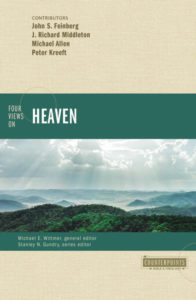
Four Views on Heaven
“Everyone wants to go to heaven, but nobody wants to die,” opens John S. Feinberg in Four Views on Heaven (23). Trying to circumvent, downplay, or ignore our mortality, as well as demurring to talk candidly about death, has bedeviled humanity from time immemorial, satirized by the likes of Monty Python’s classic “Parrot Sketch” and more recently by Netflix’s Don’t Look Up.
This book soothes death’s sting and the uncertainty about what ensues. Ten questions prompt each contributor, who is cross-examined by the other three before each shares a final rejoinder. Feinberg speaks for “traditional evangelical” Protestants. The Reformed Michael Allen reconceives heaven on earth. Wesleyan J. Richard Middleton emphasizes heaven as the resurrected new heaven and new earth. Peter J. Kreeft pens a Roman Catholic paean.
This review accepts their invitation to continue dialogue (112, 192, 199). Instead of dissecting each chapter, I offer three points of gratitude and tackle five controversies: inconsistencies, hypotheses about a spiritual heaven between death and resurrection, who will be in heaven, and what God’s creatures do and do not do in these settings.
First, I am grateful for the contributors’ collegiality amid frank disputes. Second, the chapter format with an opening explanation, cross-examinations, and a final rejoinder facilitates Christian charity and clarity. Third, contributors gladly address scholars, non-specialists, and potential intellectual disciples (153, 156, 158, 194) and they do so winsomely. I pray we proceed similarly.
Tensions and Inconsistencies
We begin with inconsistencies or tensions. First, there is an occasional failure to separate what the Bible states or teaches from contributor opinions. Feinberg distances doctrine “according to scripture” from his own understanding (24, 180). Yet he subsequently professes via dispensationalist theology to uniquely set forth “biblical teaching” over other contributors who allegedly rely on “historical figures” (24, 61, 63, 181–182). Middleton for himself ventures that Feinberg’s theology “could not survive biblical scrutiny” (42). Allen equates biblical teaching with his personal verdict on another debate: “The Bible does not present a universalism by which all persons are reunited with their God” (120, cf. 129, 185). Yet it is not difficult to find scholars who affirm what Allen denies.1
Conflating the Bible itself with our interpretations of the Bible is a constant struggle. Increasing biblical literacy and defusing rebellion against God are vital; so is distinguishing our preferred theologies and professional interpretations from the Bible itself.
Donning the authority of tradition must also be modest. As Feinberg ripostes to the other three contributors, the relative newness of his dispensationalism neither proves it nor refutes it (62–63). The universalism that Allen (and Feinberg) dismiss has precedents throughout Christian history.2 Aligning with predecessors nevertheless carries weight. Other contributors rightly protest labeling Feinberg’s chapter “traditional evangelical.” Feinberg barely engages tradition overtly and his is not the sole traditional evangelical model. Responsible encounters with history will vary just as biblical interpretations do.
Contributors elsewhere acknowledge that the Bible can be inconclusive, and historical theology inadequate to reveal all that we want to know about the afterlife. Middleton reproaches “crystal-ball gazing” (49, 90). Allen asserts that God grants us further wisdom at just the right time when we would most benefit from receiving it (135). Kreeft cites 1 Corinthians 2:9 to counsel “humble holy agnosticism . . . [when] the only thing we know is that we cannot know” (55).
These concessions are apropos, but underrating capacities to investigate any topic can hinder inquiry and seal epistemological doors that need not be shut. We must not punt to mystery too quickly. “It is the glory of God to conceal a matter; to search out a matter is the glory of kings” (Proverbs 25:2). In the same manner, it is the glory of scholars to advance and analyze the best data available.
A fourth tension regards ethics. Kreeft and Middleton ask how ethical behavior in our fallen world deviates from thriving in a sinless afterlife (88, 93, 107–108, 143). Middleton maintains, “the purpose of eschatology is ethical…to inspire us to live toward that future even now” (93). Allen writes: “In the business world investment dries up when the future remains murky and unclear; similarly, Christian or religious sacrifice will invariably flag to the extent that eschatological expectations are ambiguous or unsettled” (133).
It is curious then that Allen directly devotes less than three pages, Feinberg and Kreeft less than two, and Middleton less than one to the prompt: “How does your view of our end relate to our present life” (40–41, 93, 107–108 133–135)? How we anticipate life after death affects life today. Effective eschatology evokes joy, hope, and righteous action for creatures battered by sin and death (Romans 8:22–23). Four Views of Heaven does nominal justice to its professed ethical priorities.
What Happens between Death and Resurrection?
Isaiah 65:17–25, 66:18–24, 2 Peter 3:11–13, and Revelation 21–22 picture a new heaven and new earth where God’s people dwell following their physical resurrections. Four Views on Heaven also reflects on whether people’s souls, spirits, or consciousnesses at death go to a penultimate spiritual heaven before God later resurrects them (9). Feinberg, Allen, and Kreeft say yes.3 Middleton says no.4 Kreeft briefly appreciates mystical foretastes of heaven (10, 17), and proclaims purgatory precedes paradise (162–163, 172, 201).
Feinberg sketches a dispensational end-times chronology (24–26, 28–33). Since the book’s title is Four Views on Heaven, not Four Timetables for How the World Ends, Feinberg’s space dedicated to Armageddon, the Rapture, and the Millennium might better apply to the penultimate spiritual heaven, or to the new heaven and new earth.
Second, I sympathize with Feinberg, Allen, and Kreeft that the physically dead are in a disembodied conscious state until resurrection but I do not say that the Bible demands this view. The Rich Man and Lazarus story dramatizes something like it (Luke 16:19–31). The physically deceased Moses accompanies Elijah at Jesus’s transfiguration. Jesus corrects the Sadducees who do not believe in resurrection by insisting that all people are alive to God, specifically the patriarchs Abraham, Isaac, and Jacob (Matthew 22:32). Jesus on the cross tells the dying repentant brigand, “today you will be with me in paradise” (Luke 23:43). If Jesus meant that very day, we are hard pressed to defer his promise to the distant future. Paul signals in 2 Corinthians 5:6–9 and Philippians 1:21–24 that to be absent from the body is to be present with the Lord. Kreeft comments on the ancestral hall of faith in Hebrews 11–12: “They are not all ‘witnesses’ in the sense of martyrs, but they are all a ‘great cloud of witnesses’ in the broader sense, like spectators in the stadium that has become the earth” (58). In Revelation 6:9–10, God comforts martyrs under the heavenly altar who await God’s judgment on their persecutors. In Revelation 4–5, 7:9–17, 11:16–19, and 19:1–8, a heavenly multitude in part prior to the new heaven and new earth includes humans with twenty-four elders.
Middleton argues elsewhere that some of the aforesaid selections are compatible with loss of consciousness between death and resurrection.5 The Bible uses “sleep” and “rest” as metaphors for death or heavenly reward. Read in light of the previous verses, sleep and rest plausibly extend the Sabbath or are figures of speech. “Intermediate” spiritual paradise, or rest from earthly labor need not negate higher hopes in a restored creation (131). Feinberg (30–31), Kreeft (158–159, 164), Middleton (143–144) and Allen (31) are all convinced that a conscious disembodied state is less than God’s ideal for humans.
Third, the book declines to evaluate near death, out of body, dream, or visionary experiences. Yet, those experiences would seem to add important data to the conversation that should have been considered.6
Fourth, Kreeft prescribes purgatory to transform imperfect sinners into sinless saints (162–163, 199–201). A number of prominent Protestant thinkers would agree.7 Middleton postpones the sinner’s transformation to the new heaven and new earth (191). Allen foresees “radical change” at or after death without purgatory (116, 132, 134, 193). Feinberg scorns purgatory as sustaining “very little, if any, scriptural support” (181–185).
Kreeft replies with what he sees are clues to purgatory in the Bible (165–168, 199–201). I would add to his examples biblical fire imagery that represents divine purification in this life and the next.8 Kreeft concedes purgatory “may even be instantaneous” (165, 200). But if God transforms people at death or at Jesus’s return “in a flash, in the twinkling of an eye,” why invoke purgatory?
Who Will (We) Be in Heaven?
Contributors agree that humans in heaven grow more like Jesus.9 We will also be ourselves, not someone else, just as Jesus was the same person when he died and rose from the dead. However, Feinberg’s phraseology is troubling: “all distinctions based on ethnicity, race, gender, etc. won’t matter. . . I see nothing in Scripture that suggests these distinctions will matter” (33). Feinberg is surely aware that every nation, tribe, and tongue praise God in Revelation 5:9–10, 7:9–12. The risen Jesus was not always recognized right away, but where is any evidence that his resurrection causes these features of his humanity to no longer matter? Does he slough them off in his ascension?
A second quarrel is who participates in heaven. Feinberg denies the chance of post-death conversion for anyone (181–183). Does Feinberg believe that Jesus forsakes everyone who lacks conceptual sophistication to explicitly receive Jesus as savior—infants or children who die young, the severely disabled, those who lived before Jesus’s earthly sojourn, or those who live and die without grasping the Gospel? James K. Beilby’s work on evangelism after death for those who did not know the Gospel or knew only distortions of it is one of countless resources for these concerns.10 Potential discipleship after death comports with Kreeft’s suggestion that Christians in heaven teach and learn from (former?) practitioners of other religions, but Kreeft’s biblical basis for this is imprecise (152, 164–166, 176, 201).
What Will We Not Do in Heaven?
Contributors generally concur on what we will not do in heaven: We will not sin or wish to sin. We will “not get sick, experience the debilitating aspects of aging, or die” (37). We will not be traumatized by past events since we will see them in redemptive perspective (39–41, 51, 128, 172–175). Feinberg avows that we will be finished grappling with spiritual warfare (37). This happy state is more feasible for the new heaven and new earth view than for the intermediate spiritual heaven view, which holds that Armageddon and the souls under the altar are still to follow the intermediate state.
The contributors deny or are skeptical that anyone will be married, make love, or genetically reproduce. Akin to C.S. Lewis’s view,11 the authors hold that the finest marriages will be replaced by wider joyful companionship and sex will be eclipsed by greater pleasures (38, 90, 108, 124–125, 141). We will love parents, children, and spouses who are in heaven, but marriage, sex, and biological reproduction will be obsolete. Despite the claims of these authors, there is good reason to think that the traditional view about marriage and sex in the afterlife should be revisited. Scot McKnight, for example, has questioned the interpretation of the classic text on this issue, Luke 20:27–40.12
What Will We Do in Heaven?
Four Views on Heaven forecasts that we will love God, see Jesus, savor social relationships, love our neighbors as ourselves, feast, heal, learn, create or listen to music, worship, justly rule the earth with diverse talents and skills, revel in the natural world, and cultivate the world’s goods, riches, and multicultural treasures. If one supplements the risen Jesus’s example in the Bible, we will possess refurbished flesh and bones, dignifying physical markers, clothing, capacities to communicate, cook, eat, touch, teleport, and God knows what else.
Three conflicts persist with and among contributors. How will we perceive God? Do humans have access to both the new earth and new heaven? What appetizing role does food play?
Feinberg cites Matthew 5:8 that the pure in heart shall see God. He takes “God” to mean Jesus in his glorified human nature since there is “nothing to see visually” of God the Father, nor God the Holy Spirit (36). Father and Spirit may make their presence known through physical media as they do at Jesus’s baptism, but “nothing about our glorification suggests that glorified humans can see invisible things” (36, 35, 137–138). Allen also focuses on Jesus, God the Son becoming human so that we can “behold the face of God” (53–54, 126–128). Allen and Middleton acknowledge friction with God telling Moses that no one can see God’s face and live (Exodus 33:19–20) while other Bible characters are grateful to see something of God without dying (145–148). Kreeft applies 1 Corinthians 13:12: “for now we see in a mirror dimly, but then face to face” (163).
If Feinberg and Allen intend us to see Jesus but not God the Father, nor God the Holy Spirit except through secondary phenomena, how does the afterlife exceed past theophanies recorded in scripture? In addition, what of the several prophetic earthly visions of God in heaven cited in the Bible? And what should we make of the joyous claim in Revelation: “Look! God’s dwelling place is now among the people, and he will dwell with them. They will be his people, and God himself will be with them and be their God. The city does not need the sun or the moon to shine on it, for the glory of God gives it light, and the Lamb is its lamp” (4:1–11, 21–22)? May God equip our resurrected bodies to behold his glory and grace!
Feinberg thinks we will have access to the new heaven and new earth as separate regions (33, 97–99, 136–140). Allen and Middleton argue that we will abide on earth since the holy city, the New Jerusalem, comes down from heaven to earth. Kreeft thinks “both and neither” due to a new order of space, time, motion, matter, and energy (201–202). I am reluctant to restrict access if the essence of the passages insinuates a new unity of heaven and earth.
On feasting in the new heaven and new earth, Middleton mentions that the resurrected Jesus ate fish (89). Kreeft wonders with St. Bridget if heaven contains an immense lake of beer (168–169). If Jesus and St. Bridget are reliable indicators, some new heaven or new earth citizens will not be teetotalers, and others will be pescatarians (Luke 24:41–43; cf. John 21:1–16).13
Feinberg foresees banquets like the marriage supper of the Lamb but is unsure whether we will eat for sustenance as well as pleasure (37–39). He overconfidently reckons that “the Lord’s Supper will not be celebrated, because Jesus told his disciples to remember him this way ‘until he comes’ (1 Corinthians 11:26)” (35) but Jesus also told his disciples at the Lord’s Supper: “I will not drink this fruit of the vine from now on until that day when I drink it new with you in my father’s kingdom (Matthew 26:28; italics added). Jesus may simply mean that he will drink wine (or grape juice!) in God’s kingdom. Or, “for whenever you eat this bread and drink this cup, you proclaim the Lord’s death until he comes” serves as a “remembrance . . . until” that time without precluding “mystic sweet communion” in a eucharistic new heaven and new earth.
None of these critiques minimize Four Views on Heaven’s significance to analytic reflection on life after death, or to what heaven or a revitalized new heavens and earth will unveil according to four vigorously Christian perspectives. Each contributor is erudite without being obscure, attentive to hermeneutics but not slavish to jargon, and intelligible without being simplistic. Vibrant, ongoing scholarship can lessen if not eliminate their weaknesses utilizing history, theology, ethics, and the Bible. May graceful conversation probing death, resurrection, and all that they entail progress for heaven’s sake and ours.
Cite this article
Footnotes
- See my review, “Shall All Be Saved? David Bentley Hart’s Vision of Universal Reconciliation,” Christian Scholar’s Review 50, no. 1 (2020): 85–95.
- Ilaria L. E. Ramelli, The Christian Doctrine of Apokatastasis: A Critical Assessment from the New Testament to Eriugena (Leiden, NL: Brill, 2013); Michael J. McClymond, The Devil’s Redemption: A New History of Interpretation of Christian Universalism: 2 Volumes (Grand Rapids, MI: Baker Academic, 2018). See Benjamin B. DeVan, review of The Devil’s Redemption, by Michael J. McClymond, Faith and Philosophy 36, no. 3 (2019): 413–419, https://doi. org/10.5840/faithphil2019363130.
- See pages 27–28, 58, 100–101, 131–132, 141, 162–168.
- See pages 46–48, 89, 92–93, 143–145, 191.
- Richard Middleton, A New Heaven and a New Earth: Reclaiming Biblical Eschatology (Grand Rapids, MI: Baker Academic, 2014), 220–237.
- See especially Carol Zaleski, Otherworldly Journeys: Accounts of Near-Death Experience in Medieval and Modern Times (New York: Oxford University Press, 1987); Jerry L. Walls, Heaven: The Logic of Eternal Joy (New York: Oxford University Press, 2002), 133–160.
- For example, Peter Taylor Forsyth, This Life and the Next: The Effect of This Life of Faith in Another (Boston, MA: The Pilgrim Press, 1948), 37; C. S. Lewis, The Great Divorce (HarperSanFrancisco, 2001), 68; C. S. Lewis, Letters to Malcolm: Chiefly on Prayer (London: Geoffrey Bles, 1963), 139–140; Clark Pinnock, “Response to Zachary Hayes,” in Four Views on Hell, Preston Sprinkle, ed. (Grand Rapids, MI: Zondervan, 2016), 127–131; John Polkinghorne, The God of Hope and the End of the World (New Haven, CT: Yale University Press, 2003), 130–133; William Edwin Sangster, The Path to Perfection: An Examination and Restatement of John Wesley’s Doctrine of Christian Perfection (New York: Abingdon Press, 1943), 65–70; Dorothy L. Sayers, “Introduction” to Dante, The Divine Comedy II: Purgatory (London: Penguin, 1955); Jerry L. Walls, Purgatory: The Logic of Total Transformation (New York: Oxford University Press, 2012); William H. Willimon, Who Will Be Saved? Nashville, TN: Abingdon Press, 2008), 84–87.
- 1 Corinthians 3:12–13; Hebrews 12:29. See Robin Parry and Jerry L. Walls in Four Views on Hell, 145–173, 186–189 who discuss a number of such biblical passages.
- See pages 16, 23, 29–30, 36–37, 51, 158–159, 191, 194–198, 202–204.
- James K. Beilby, Postmortem Opportunity: A Biblical and Theological Assessment of Salvation after Death (Downers Grove, IL: IVP Academic, 2021).
- Compare C. S. Lewis on sex and chocolates in Miracles: A Preliminary Study (New York: HarperOne, 1996), 260–261.
- Scot McKnight, The Heaven Promise (Colorado Springs, CO: Waterbrook Press, 2015), 169–170.
- For one English rendering of this poetic tradition see “The Story of How St Brigid Turned Bathwater to Beer,” Irish Post, February 1, 2022, https://www.irishpost.com/news/ the-story-st-brigid-bathwater-beer-178498.























